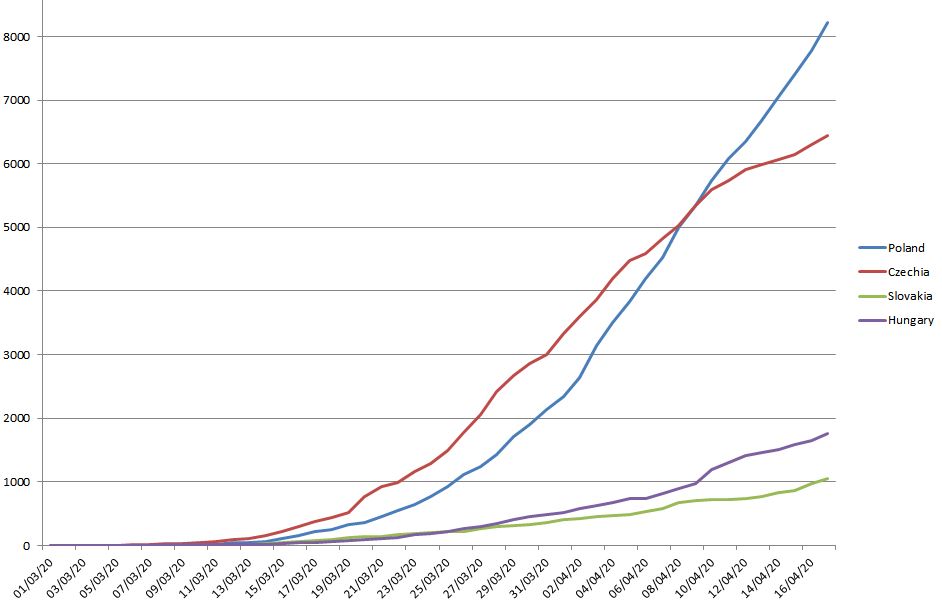Poland – The Polish government announced on Thursday evening a first series of measures designed to ease the lockdown and revive the economy, as this year seems set to bring the country’s first recession since 1992. The S&P rating agency expects a 2% decline in GDP this year, although it forecasts growth of 4.8% in the following year. According to the IMF, Poland’s GDP may contract by as much as 4.6% this year, to be followed by growth of 4.2% in 2021. To enable the economy to bounce back as quickly as possible, and to avoid falling into a downward spiral that would lead to a depression, Prime Minister Mateusz Morawiecki has had to renege on his earlier promise of a balanced budget this year. Two plans containing measures to support business, dubbed the “anti-crisis shield”, have been approved by parliament (the second set of measures went through its final reading on Thursday night), and some media are already announcing that a third plan is being drafted.
While social distancing measures were taken at an earlier stage of the epidemic in Poland, the lockdown is less stringent than in France, Italy, Spain, or the United Kingdom. Thus, most stores have been able to remain open, except for those in commercial centres, where only food supermarkets are still functioning. Since Thursday, April 16, people have been required to cover their mouths and noses in all places where they are close to others (in stores, in workplaces, on the street when there are people nearby, on city transport, in private cars when travelling with persons from different households, etc.), while continuing to keep a minimum distance of 2 metres apart whenever possible. Thus, Poland has made face masks compulsory, as was done in March in the Czech Republic and Slovakia, two countries where the epidemic has progressed more slowly (at least in absolute terms).

Remote working remains mandatory whenever it is possible, and no date has yet been set for the reopening of schools. From Monday, April 20, stores are allowed to admit more customers at one time: four per checkout for stores under 100 m², and one person per 15 m² for stores over 100 m² (since 24 March the limit had been three customers per checkout regardless of the size of the store). In places of worship there can now be one person per 15 m², instead of the maximum of five worshippers that had been in force since 24 March. Access to parks and woods is again authorised. Children over the age of 13 can again go out and move around unaccompanied.
A weekly reassessment was announced, and new measures will be taken in the light of the evolution of the epidemic.
After this first stage, a second stage is planned, with no set date, when hotels, libraries, museums and art galleries will reopen. Then, at the third stage, hairdressers and beauty salons will be allowed to reopen, as well as commercial centres (but with restrictions) and on-the-spot consumption in restaurants. Then will come a fourth stage for all other venues (such as fitness clubs, theatres and cinemas), with new sanitary rules.
Businesses will of course be looking forward to the reopening of schools so that they can get back employees who are currently forced to stay at home to take care of children, but – as noted above – no date has yet been announced, and it could well be that schools will not reopen until September. Polish employers will also be expecting the return of some 150,000 Ukrainians who have gone back to their country, in particular so that they can speed up construction work, which has been slowed by the sanitary measures and the shortage of labour (construction has not been shut down in Poland). But for this to happen, they will have to wait for the reopening of borders to foreigners, for which no date has yet been given. In addition to the shortage of labour (unemployment in Poland stood at only 2.9% in January according to the Eurostat calculation method, or 5.5%according to the criteria of the Polish statistical office, GUS), companies have been faced with a sharp drop in consumption since the month of March, as well as the stoppage of “non-essential” activities and the strong economic downturn in their main export markets.
To allow businesses to survive this period, the government of Mateusz Morawiecki has pushed several major measures through parliament. The main ones are: an allowance for the self-employed for interruption or reduction of activity at 80% of the minimum wage, a three-month exemption from social security contributions for the self-employed and companies employing up to 9 people, a partial exemption from such contributions for larger companies, the payment of wages by the state up to a maximum of 50% of the minimum wage, or up to a maximum of 40% of the average salary in case of reductions of working time, as well as opportunities for tax deferral, all of these benefits being conditional on a significant fall in turnover compared to the same month of last year. In addition, the two “anti-crisis shields” adopted to date contain measures to support the most affected sectors, such as transport and tourism, as well as measures to boost credit, preferential loans which will be partly non-repayable for companies abstaining from laying off workers, the possibility of suspending the repayment of bank loans for a limited period of time, etc.
Other measures are intended to support production, like the continuation of major infrastructure works, with new announcements made in April, as well as, for example, the launch of a large-scale programme for the production of face masks, coordinating the capacities of some 200 sewing workshops scattered throughout the country.
All of these measures have a potential total value estimated at 212 billion zloty (approximately 49 billion euro at the exchange rate prior to the epidemic, or over 45 billion euro at the current rate), or approximately 10 per cent of Poland’s GDP.




